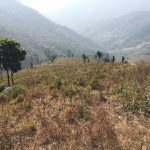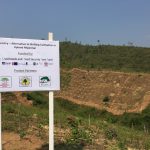29 downloads
Title of document: Organic Agriculture as an Opportunity for Sustainable agricultural Development Authors: Verena Seufert Ministry/Government Agency/Organisation: Institute for the Study of International Development Year of publication: 2012 Geographic focus: World wide Url original document: https://www.mcgill.ca/isid/files/isid/seufert.pb13.pdf Summary: We need drastic change in the global food system in order to achieve a more sustainable agriculture that feeds people adequately, contribute to rural development and provide livelihood to farmers without destroying the natural resource basis. Organic agriculture has been proposed as an important means for achieving this goals. Organic agriculture currently covers only a small area in developing countries but its extent is continuously growing as demand for organic products is increasing. Read More
10 downloads
Title of document: Integrated Pest Management for Sustainable Intensification of Agriculture in Asia and Africa Authors: Jules Pretty and Zareen Pervez Bharucha Ministry/Government Agency/Organisation: Year of publication: 2015 Geographic focus: Asia and Africa Url original document: http://www.mdpi.com/2075-4450/6/1/152 Summary: Integrated Pest Management (IPM) is a leading complement and alternative to synthetic pesticides and a form of sustainable intensification with particular importance for tropical smallholders. Global pesticide use has grown over the past 20 years to 3.5 billion kg/year, amounting to a global market worth $45 billion. The external costs of pesticides are $4–$19 (€3–15) per kg of active ingredient applied, suggesting that IPM approaches that result in lower pesticide use will benefit, not only farmers, but also wider environments and human health. Evidence for IPM’s impacts on pesticide use and yields remains patchy. We contribute an evaluation using data from 85 IPM projects from 24 countries of Asia and Africa implemented over the past twenty years. Read More
25 downloads
Title of document: Innovative Markets for Sustainable Agriculture. How innovations in market institutions encourage sustainable agriculture in developing countries Authors: Loconto, A.; Poisot, A.S.; Santacoloma, P. Ministry/Government Agency/Organisation: FAO Year of publication: 2016 Geographic focus: Developing countries Url original document: http://www.fao.org/publications/card/en/c/53d39282-ddd7-460c-a27f-3d5015eea7ca/ Summary: Between 2013 and 2015, the Food and Agriculture Organization of the United Nations (FAO) and the French National Institute for Agricultural Research (INRA) undertook a survey of innovative approaches that enable markets to act as incentives in the transition towards sustainable agriculture in developing countries. Through a competitive selection process, 15 cases from around the world provide insights into how small-scale initiatives that use sustainable production practices are supported by market demand, and create innovations in the institutions that govern sustainable practices and market exchanges. The results are: (i) system innovations that allow new rules for marketing and assuring the sustainable qualities of products; (ii) new forms of organization that permit actors to play multiple roles in the food system (e.g. farmer and auditor, farmer and researcher, consumer and auditor, consumer and intermediary); (iii) new forms of market exchange, such as box schemes, university kiosks, public procurement or systems of seed exchanges; and (iv) new technologies for sustainable agriculture (e.g. effective micro-organisms, biopesticides and soil analysis techniques). The public sector plays a key role in providing legitimate political and physical spaces for multiple actors to jointly create and share sustainable agricultural knowledge, practices and products. Read More
11 downloads
Title of document: Finding alternatives to swidden agriculture: does agroforestry improve livelihood options and reduce pressure on existing forest? Authors: Syed Ajijur Rahman, Jette Bredahl Jacobsen, John Robert Healey, James M. Roshetko, Terry Sunderland Ministry/Government Agency/Organisation:University of Copenhagen, Bangor University & CIFOR Year of publication: 2016 Geographic focus: Indonesia Url original document: http://link.springer.com/article/10.1007/s10457-016-9912-4 Summary: Swidden cultivation can contribute to deforestation and land degradation, which can subsequently result in a number of serious environmental problems. This paper examines the economic and social potential of agroforestry systems and the barriers to their widespread adoption, as a land use alternative to swidden cultivation, which may potentially help protect local forest. Based on farmers’ and experts’ assessment, costs and benefits have been estimated, which show that the two investigated agroforestry systems have higher net present value and benefit-cost ratio (B/C) than the two swidden cultivation systems. Tree ownership also creates more permanent rights to farmland and is prestigious in the community. Agroforestry products (fruit, vegetables etc.) have high monetary value and help strengthen social cohesion when shared with neighbors. Read More
4 downloads
Title of document: Agroforestry for Livelihood Security in Agrarian Landscapes of the Padma Floodplain in Bangladesh Authors: Syed Ajijur Rahman, Muhammad Hasan Imam, Denyse J. Snelder, Terry Sunderland Ministry/Government Agency/Organisation: Small-scale Forestry Year of publication: 2012 Geographic focus: Bangladesh Url original document: http://link.springer.com/article/10.1007/s11842-012-9198-y Summary: In the Padma floodplain of Bangladesh, the traditional system of agriculture has become unsustainable due to high population growth. Mango-based agroforestry which has been practiced by the farmers since the 1990s, is a promising alternative and is considered as one of the few options to lift farmers out of poverty and improve livelihood security. This paper examines the potential of mango-based agroforestry to improve livelihoods, using data collected by rapid rural appraisal, farmer participatory research, stakeholder analysis and a farm household survey in six representative villages in the floodplain. Farmers with the least land were found to allocate a higher percentage of their land to agroforestry, and the increased income from agroforestry compared to other agricultural systems helps reduce relative poverty. This income maintains basic household needs, providing food security and fuelwood, and contributes to healthcare, housing and sanitation conditions, and meeting educational expenses. Read More
10 downloads
Title of document: Making Rice Production More Environmentally-Friendly Authors: Norman Uphoff and Frank B. Dazzo Ministry/Government Agency/Organisation: SRI International Network and Resources Center, International Programs, College of Agriculture and Life Sciences, Cornell University, Ithaca, NY 14853, USA Year of publication: 2016 Geographic focus: World wide Url original document: www.mdpi.com/journal/environment Summary: Irrigated rice production is one of the most essential agricultural activities for sustaining our global population, and at the same time, one of the agricultural sectors considered most eco-unfriendly. This is because it consumes a large share of available freshwater resources, competing with varied ecosystems as well as other economic sectors; its paddy fields are responsible for significant emission of greenhouse gases; and the reliance on chemical fertilizers and various agrochemicals contributes to pollution of soils and water systems. Read More
2 downloads
Title of document: Alder trees enhance crop productivity and soil microbial biomass in tea plantations Authors: P.E. Mortimer, H. Gui, J. Xu, C. Zhang, E. Barrios, K.D. Hyde Ministry/Government Agency/Organisation: Applied Soil Ecology Year of publication: 2015 Geographic focus: China Url original document: www.elsevier.com/located/apsoil Summary: Monoculture farming systems lead to soils depleted of nutrients and diminished microbial functional diversity, disrupting process crucial to maintaining soil health. The planting of trees in these monoculture systems is one way to improve soil nutrition and biodiversity. Therefore, the objective was how planting the N fixing tree Alnus nepalensis (7 years old), into monoculture tea (Camellia sinensis var., assamica) plantations (32 years old), influences the soil fungal and bacterial communities, and how this impacts on tea productivity. Read More
4 downloads
Title of document: Ecological Intensification Management of Maize in northeast China: Agronomic and Environment Response Authors: Rongrong Zhao, Ping He, Jiagui Xie, Adrian M. Johnston, Xinpeng Xu, Shaojun Qiu, Shicheng Zhao Ministry/Government Agency/Organisation: Agriculture, Ecosystems and Environment Year of publication: 2016 Geographic focus: China Url original document: www.elsevier.com/located/agee Summary: Optimum field management practices need to be developed and improved to solve the challenge of increasing food production while retaining the ecological integrity of farming system underlying the goal of sustainable agriculture. In this study, the concept of ecological intensification (EI) was applied to a spring maize cropping system in Jilin province, China during 2009-2013. Results indicated that the average grain yield was 11.8 t/ha in the EI treatment; while the farmers’ practice (FP) treatment had an average of 11.4 t/ha grain yield across five seasons. Read More

79 downloads
Case study's fact sheet: Agroforestry Alternatives to Shifting Cultivation in Upland Myanmar, Chin State Supported by: World Agroforestry Center East and Central Asia (ICRAF-ECA) In practice since: 2015 Geographic focus: Myanmar School of agroecology: Agroforestry >>> see on map Read More

48 downloads
Case study's fact sheet: Agroforestry Alternatives to Shifting Cultivation in Upland Myanmar Supported by: World Agroforestry Center East and Central Asia (ICRAF-ECA) In practice since: 2016 Geographic focus: Myanmar School of agroecology: Agroforestry >>> See on map Read More

 Asia & Mekong Region
Asia & Mekong Region  Cambodia
Cambodia  Laos
Laos  Myanmar
Myanmar  Other
Other  Vietnam
Vietnam